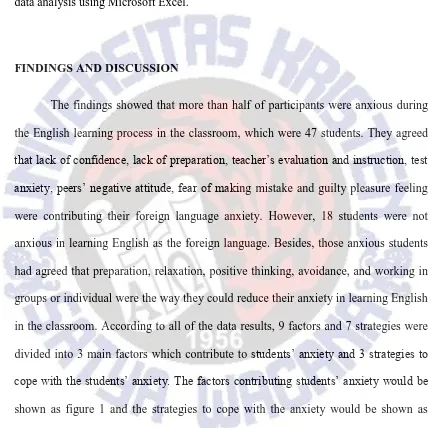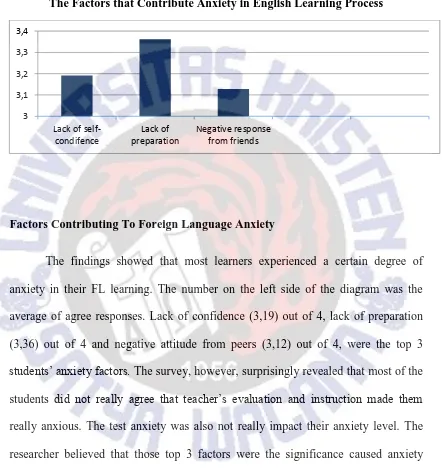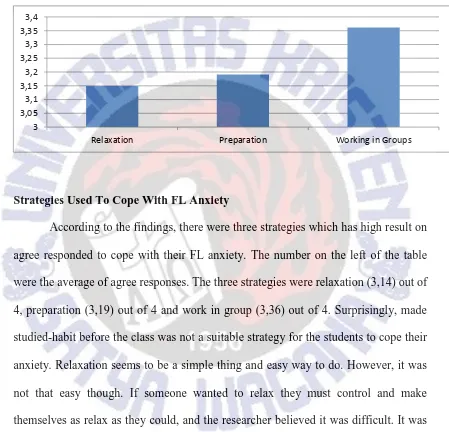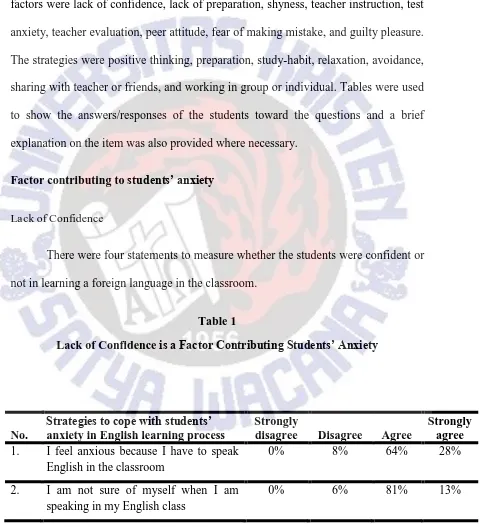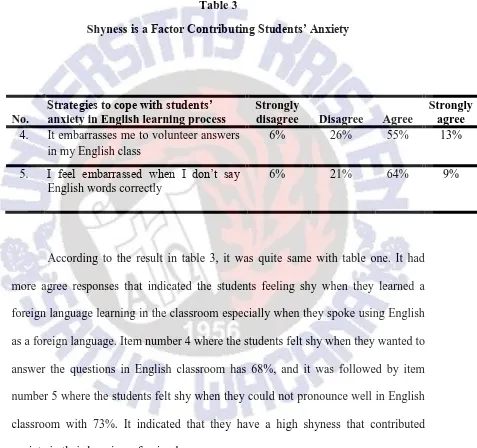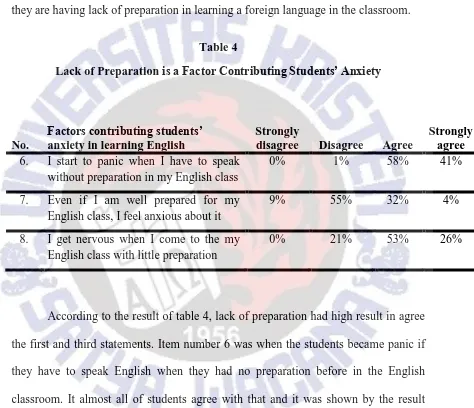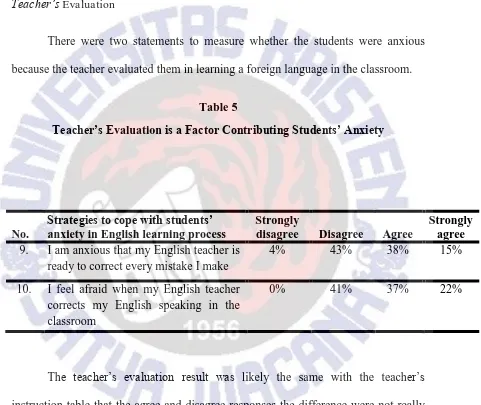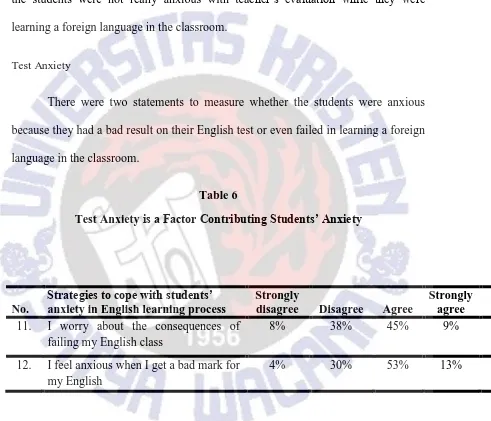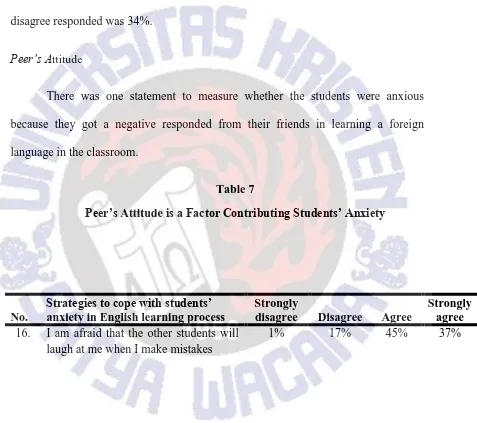STUDENTS’ ANXIETY IN
ENGLISH LEARNING PROCESS
THESIS
Submitted as a Partial Fulfillment of
The Requirements for the Degree of
Sarjana Pendidikan
ONES KURNIAWAN SANTOSO
112013014
ENGLISH LANGUAGE EDUCATION PROGRAM
FACULTY OF LANGUAGE AND ARTS
UNIVERSITAS KRISTEN SATYA WACANA
SALATIGA
vi
COPYRIGHT STATEMENT
This thesis contains no such material as has been submitted for examination in any course or accepted for fulfillment of any degree or diploma in any university. To the best of my knowledge and belief, this contains no material previously published or written by any others except due reference is made in the text.
vii
TABLE OF CONTENT
COVER PAGE
PERNYATAAN TIDAK PLAGIAT ... ii
PERNYATAAN PERSETUJUAN AKSES ... iii
PUBLICATION AGREEMENT DECLARATION ... iv
APPROVAL PAGE ... v
Possible Factors Contributing to Students’ Anxiety ... 4
Effect of Foreign Language Anxiety on Students ... 7
Possible Strategies to Cope the Anxiety ... 9
THE STUDY ... 11
Context and Participant ... 12
Instruments ... 13
Data Collection Procedures ... 14
Data Analysis Procedures ... 15
FINDINGS AND DISCUSSION ... 16
Overview of the findings ... 16
Figure 1. Top 3 table of Factors that Contribute Anxiety in English Learning ... 17
Figure 2. Top 3 table of Strategies to Cope with Anxiety in English Learning ... 20
Table of Factor Contributing Students’ Anxiety ... 22
Table 1. Lack of confidence ... 22
viii
Table 3. Shyness ... 25
Table 4. Lack of preparation ... 26
Table 5. Teacher’s evaluation ... 27
Table 6. Test anxiety ... 28
Table 7. Peer’s attitude ... 29
Table 8. Fear of making mistake ... 30
Table 9. Guilty pleasure ... 31
Table of Strategies to Cope with the Anxiety ... 31
Table 1. Positive thinking ... 32
Table 2. Preparation... 33
Table 3. Study-habit ... 34
Table 4. Relaxation ... 35
Table 5. Avoidance ... 36
Table 6. Sharing with teacher or friends ... 37
Table 7. Working in group or individual ... 38
CONCLUSION ... 39
ACKNOWLEDGEMENTS ... 41
REFFERENCES ... 43
1 INTRODUCTION
2
When I did my observation in SMA Kr. Satya Wacana, there was a really active class but when the students were invited to have a discussion and conversation in English, most of them chose to use their mother tongue. This situation was one of the reasons why this study was conducted, that is to address whether the students were having foreign language anxiety or not.
There have been previous studies investigating about student’s foreign language anxiety. Study conducted by Zheng (2008) found that anxiety situations
may interfere the students’ motivation in learning foreign language process. Some other studies have focused on finding out how the students cope with the foreign language anxiety (Nuranifar, 2014). However, there has been limited study conducted within the context of Indonesian foreign language education, especially in a private school like SMA Kr. Satya Wacana. Therefore, according to the problems explained above, this research is trying to investigate (1) the factors that students believe to be the factors contributing their second language anxiety in learning a foreign language and (2) the strategies that the learners use to cope with their foreign language anxiety.
3 LITERATURE REVIEW
Defining Anxiety
Talking about anxiety, many people have various different answers. Skehan (1989) and Young (1991) as cited in Ohata (2005) said that language anxiety is a type of anxiety specifically associated with L2 and it can arise from many kinds of source.
“Anxiety is one of the most well documented psychological phenomena” (Zheng, 2008, p.2). Spielberger (1983) as cited in Huang (2012) defines anxiety as the subjective feeling of tension, apprehension, nervousness and worry associated with the arousal of the nervous system. Generally, anxiety can be associated with “threats to self-efficacy and appraisals of situations as threatening” (Pappamihiel, 2002, p.331). Meanwhile according to MacIntyre and Gardner (1994) as cited in Marwan (2007), anxiety is a feeling of tension and apprehension experienced by learners in the foreign language classroom. Moreover, Horwitz et al (1986) maintain that
language anxiety is “a distinctive complex of self-perceptions, beliefs, feelings and behaviors related to classroom language learning arising from the uniqueness of the
4
Possible Factors Contributing to Students’ Anxiety
The factors of foreign language anxiety are the major of this research. There are many possible factors that will influence students in having a conversation or the learning process in English. The components of foreign language anxiety can have been identified (Horwitz, et. al., 1986; MacIntyre & Gardner, 1989) to narrow down this concept into reachable issues: (1) communication apprehension or anxiety (2) Fear of negative evaluation. (3) Test anxiety. Besides those factors, I believe that there is inner and outer factor that contributes students anxious. In this case, example such as fear of making mistake, lack of confidence, test anxiety, or whatever factor that comes from them like feeling it could be assumed that inner factor can be described by those examples. On one hand, the examples of outer factors are like
teachers’ evaluation, and negative attitude from friends.
Communication Apprehension
5
cannot deliver it in a good way or clear enough for the listener, it will make the listener do not understand about what speaker says. Therefore, the students who have this problem tend to keep silent in their English class.
Fear of Negative Evaluation
Talking about evaluation, not all of students will accept evaluation in a positive way. Sometimes they will think that evaluation is negative thing and they fear of it. It is because they always concern or focus on their mistakes not about the language. Young (1991) argues, "students are more concerned about how (i.e., when, what, where, or how often) their mistakes are corrected rather than whether error correction should be administered in class" (p. 429). The role of teacher in giving evaluation is
also lowering the students’ self-esteem. Teacher thinks that their evaluation will be good for the students but it does not work, because of the concern of students only their mistakes.They are afraid to make mistakes in during the process of foreign language learning. Thus, they will always think that evaluation is a bad thing even it comes from the teacher.
Test Anxiety
“Test anxiety refers to a type of performance anxiety stemming from a fear of
6
tasks which are used to evaluate the students’ performance. The test is made by the
teacher to check the students’ understanding towards the materials that has given by
the teacher. In that test, students sometimes have a demand to themselves to get an excellent mark. However, it can be a boomerang for them because somehow it can burden them. If the result is not like what they have expected, it will make them down because they think that they have failed. As the result, the students will get frightened in the upcoming test. In addition, test will make them nervous because they are depressed by the materials to be remembered and limited times during the test. As the result, they might become blank or even forget the answer that actually they have already known.
To go deeper to inner factor, students’ confidence and preparation could be a major factor contributing their foreign language anxiety. In learning a foreign language, lack of confidence usually occurs when students realize that their conversation partners have not understood them or when they do not understand other speakers. In response to this, Tsui as cited in Nunan (1999) says that students who lack of confidence about themselves and their English necessarily suffer from communication apprehension. This shows that confidence has a big part in students’
behavior especially in learning a foreign language. Furthermore, building students’
confidence is an important part of teacher’s focus of attention. He and Chen (2010) as
cited in Juhana (2012) stated the main cause of students’ confidence is their low
7
speak English well. Moreover, Brown (2001) as cited in Juhana (2012) argued that the other cause is the less encouragement from the teacher. In this case, teacher should not only teach but also encourage them to learn a foreign language.
Furthermore, there is still a factor that most cause of anxiety in learning a foreign language which is preparation. We know exactly that preparation is a thing that is really needed for mankind before they want to do something. For example before having an exam, they will study, before having a vacation they have to pack their belonging, etc. Same as in learning a foreign language learning, if students do not prepare first they will get anxious. As supported by Smith & Schroth (2014) in their research, it shows that 73% students in 2 Spanish classes feel their performance in learning a foreign language was affected because they lack of preparation. Thus, they also added that preparation is the main thing if you want to learn something new. If we talk about an inner factor, there will be an outer factor. Besides teacher’s
evaluation, whether it is on the students’ performance, task, or test, friends are also
can contribute anxiety. It is good if your friends can give a support, encourage and motivation to you, but how about if they do a bad thing such as mocking and make
fun of someone’s mistakes? They laugh at someone’s pronounce, articulation and
intonation, and also accent when he or she speaks a foreign language. Effects of Foreign Language Anxiety on Students
8
anxious is a parasite especially in students’ speaking ability because according to
Onwuegbuzie, et. al. (1999) as cited in Mahmoodzadeh (2012), the existence of
foreign language anxiety causes the fluency on students’ speech. Na (2007) and Spielmann and Radnofsky (2001) as cited in Mahmoodzadeh (2012) have searched
9 Possible Strategies to Cope with the Anxiety
Foreign language learning anxiety has been the subject of research that indicates anxiety has a big problem for many foreign language learners. Most studies on language anxiety also concentrate on understanding the mechanism of anxiety in the process of language learning either in foreign language or second language settings (MacIntyre and Gardner, 1994) as cited in Marwan (2007). However, there are very few which are directed at identifying the strategies used by language learners to cope with their language anxiety in their FL in a classroom. This issue is one of the concerns to be investigated in this survey.
According to study that was conducted by Pappahimiel (2002), one of the strategies to cope the anxiety is avoidance. Students in his study reported that avoidance is the most common strategy to reduce their language anxiety. Another strategy in his study is making close friends who have a better L2 and have a less anxious. Logically this can be true because the one who has a lack in L2 and has anxious in learning L2 can get a motivation from their friends and can learn with them which will make the weak one develop by each day to start to leave their lack of L2 and their anxiousness. Look at that strategy, we can conclude those strategies are from the students themselves. Moreover, teacher can also be the one who reduce the
10
Actually, there are many strategies to reduce the anxiety problem in students’ psychological in learning a foreign language whether it is the complex one or the simple one such as relaxation. According to Grasha, (1987) as cited in Mahmud & Suryana, (n.d.) breathing deeply in and out for three to five minutes is an effective way to reduce tension. However, this strategy only works with on situational anxiety, like students that have to present or speak in front of the class. It is not really efficient for reducing high anxiety. Nevertheless, there are still some strategies that have high impact on reducing the anxiety. Study conducted by Mahmud & Suryana (n.d.) shows that preparation was the most strategy that being used to reduce their anxiety level. As I said previously, many foreign language learners find themselves nervous when they had not prepared before class. Actually, there are many ways to prepare including reading the materials before class, taking second language courses provided in or out of school, asking help from friends and teachers. I believe that students who have a good preparation will have a good performance and proficiency level. “The anxious learners may perform as good as the non-anxious learners when they have
sufficient time to prepare and practice the tasks” (MacIntyre & Gardner, 1994, cited
in Argaman & Abu-Rabi, 2002, p. 152). Therefore, anxious learners may need more extra time to study. Relaxation and preparation might be the good combination of
strategies to cope with the students’ anxiety. Moreover, I think there is still one more
11
(Kagan, (1994), as cited in Nagahashi, (2007). Therefore, working in group or cooperative learning is a strategy that can complete the combination with relaxation and preparation in coping with the anxiety in learning a foreign language.
THE STUDY
This study aimed at finding the factor that contributing students’ anxiety in learning English as the foreign language and finding the strategies to cope with the
students’ anxiety in the classroom. These are the research questions:
1. What are the factors that students believe to be the factors contributing their second language anxiety in learning a foreign language?
2. What are the strategies that the learners use to cope with their foreign language anxiety?
This study was using a mix method for the data collection. Mix method research is a methodology for conducting research involving collecting, analyzing, and integrating (or mixing) quantitative and qualitative research in a single study (Bulsara, n.d). The quantitative data had been gained from the questionnaire that was continued with the qualitative method as the explanation. The mix method was chosen because there would be opened up opportunities for richer data to be gained.
Thus, the investigation on factors contributing students’ anxiety and the strategies
12 Context and Participants
This study was conducted in SMA Kr. Satya Wacana Salatiga. This private school is located in Salatiga, Central Java, Indonesia. Particularly, the 11th grade students were active students since I was observing them in their classroom. However, their activeness changed into silence when I asked them to answer my questions in English and if I made a conversation with them, they tended to be quiet even though they were generally in the intermediate level of language proficiency.
13 Instruments
The instrument or tool that had been used to collect the data was a questionnaire. There were 2 parts of statements in the questionnaire, which were part A and part B. Part A was the factor of anxiety which was adapted and modified from Horwitz et al., (1986). It provided 19 statements. Then part B was the strategies in coping with anxiety which was adapted from Kondo and Ling (2004), and it provided 14 statements.
In the questionnaire part A, there were 9 factors contributing students’ anxiety
and 19 questions were asked to the participants. Here were the factors and the items/questions that represented them. The first one was lack of confidence with items A1, A2, A13, and A17. The second one was teacher’s instruction with items A3, A14, and A15. The third one was shyness with items A4 and A5. Then, lack of preparation with items A6, A7, and A8. Next was teacher’s evaluation with item A9
and A10. Sixth, test anxiety with items A11, and A12. Seventh, Peers’ negative
attitude with item A16, and then fear of making mistake with item A 18. The last one was guilty pleasure with item A 19.
14
and then avoidance with items B8 and B9. The second last one was sharing with items B10 and B11. Then the last one was partner working with items B13 and B14.
This questionnaire was constructed based on the 4 point-likert-scale previously invented by Renis Likert in 1932. The respondents were asked to tick one out of four stances in the questionnaire. The 4 stances ranges are started from strongly agree, agree, disagree, and strongly disagree.
Data Collection Procedures
The questionnaire to get the data was given to the 11th grade students of SMA Kr. Satya Wacana. The classes were Xi-MIA 3, XI-IIS 1, and XI-BB. But, before I got the real data, I did a piloting to XI-Lintas Minat. The first step of my piloting section, I had asked permission to the teacher to get a time for giving questionnaires. After got the permission, I gave the questionnaires to all of the students in the classroom. Then, I started to explain how to do with the questionnaire and told them that they could ask me if they had some difficulties. During the working section, there was no question related to all of the statements in the questionnaire. Nevertheless,
there was a question from some students, “if I was not anxious in learning English in the classroom, but there were some statements below which suit to me, should I
ticked it? This question was ambiguous Mr.” That question was confusing me
because before I gave the questionnaire to them, I explained if in the part which the
15
was no, they did not have to proceed to the next part. So I just said to them just ticked it.
After they finished, I took the entire questionnaire and then put them into 1 map then I analyzed the data from XI-Lintas Minat. After got the result, I came to my supervisor to report the piloting result. Moreover, I also told my supervisor about the question from some students that made me confuse. Then the result of my
consultation was adding “doubt” answer option for the ambiguous question and 5
point-likert-scale changed into 4 point-likert-scale. It was because too much neutral answered from the piloting result.
After I did the consultation and revision, I got the ready questionnaire to give it to the 3 classes to get the real data. Same like piloting, I had asked permission before giving the questionnaire. During the working, there were no questions about the questionnaire at all and the entire questions in the questionnaire were answered by the participants.
Data Analysis Procedures
16
agree = 3, strongly agree = 4), were assigned to the four Likert scale of students response in the questionnaire. This was to facilitate the researcher in the process of data analysis using Microsoft Excel.
FINDINGS AND DISCUSSION
The findings showed that more than half of participants were anxious during the English learning process in the classroom, which were 47 students. They agreed
that lack of confidence, lack of preparation, teacher’s evaluation and instruction, test
anxiety, peers’ negative attitude, fear of making mistake and guilty pleasure feeling were contributing their foreign language anxiety. However, 18 students were not anxious in learning English as the foreign language. Besides, those anxious students had agreed that preparation, relaxation, positive thinking, avoidance, and working in groups or individual were the way they could reduce their anxiety in learning English in the classroom. According to all of the data results, 9 factors and 7 strategies were divided into 3 main factors which contribute to students’ anxiety and 3 strategies to
cope with the students’ anxiety. The factors contributing students’ anxiety would be
17 FIGURE 1
The Factors that Contribute Anxiety in English Learning Process
Factors Contributing To Foreign Language Anxiety
The findings showed that most learners experienced a certain degree of anxiety in their FL learning. The number on the left side of the diagram was the average of agree responses. Lack of confidence (3,19) out of 4, lack of preparation (3,36) out of 4 and negative attitude from peers (3,12) out of 4, were the top 3
students’ anxiety factors. The survey, however, surprisingly revealed that most of the students did not really agree that teacher’s evaluation and instruction made them really anxious. The test anxiety was also not really impact their anxiety level. The researcher believed that those top 3 factors were the significance caused anxiety problem not only for the students, but also in other schools. Study conducted by Juhana (2012) stated that the cause of feeling lack of confidence of 62 second grade students in one of senior high school in Banten was their inability to speak English.
18
Brown, (2001); Eli, 1986 as cited in Keramida, (2009) stated that students lack confidence and felt that they could not speak English because they thought that they did not have the ability to speak English well and their limited knowledge of the language. I believe that this kind of feeling would hinder the students from trying to speak English as their foreign language. From that phenomenon the teacher should
concern with this issue, to get more better students’ influence participants and
achievement since the students were known with their English achievement in English competition which the researcher believed it would be really needed a high confidence in using English.
19
Last but not least, this factor had a contribute to raise the students’ anxiety. It could be seen as a simple thing in learning process in the classroom, but most of 11th
grade students were agree if peers’ negative attitude would make them anxious in learning a foreign language in the classroom. One of the negative attitude was laughing on the mistake that made by the other student. According to Hamouda (2013), fear of being laughed at was one of the causes that contributes to the passivity and reticence of students to participate in the class discussion. It was also supported by Thaher (2005) as cited in Hamouda (2013), students were afraid of being laughed at or of being criticized by others due to inaccurate pronunciation. Study conducted by Saricoban (2014), stated that fifty percent of 383 pre-intermediate students in the first year of university in majoring English preparatory were worry about the reactions of their friends. He added more that the students were very afraid to be laughed at or to be a comic figure in front of the class and they sometimes did not want to speak because of this. From this phenomenon, teacher should consider about
students’ behavior in the classroom. Teacher should make a positive attitude of each
20 FIGURE 2
The Strategies to Cope with Anxiety in English Learning Process
Strategies Used To Cope With FL Anxiety
According to the findings, there were three strategies which has high result on agree responded to cope with their FL anxiety. The number on the left of the table were the average of agree responses. The three strategies were relaxation (3,14) out of 4, preparation (3,19) out of 4 and work in group (3,36) out of 4. Surprisingly, made studied-habit before the class was not a suitable strategy for the students to cope their anxiety. Relaxation seems to be a simple thing and easy way to do. However, it was not that easy though. If someone wanted to relax they must control and make themselves as relax as they could, and the researcher believed it was difficult. It was because someone could not make themselves comfort with everything surround them, and tried to keep calm when they were nervous. Nevertheless, relaxation was a must. When someone relax, it would make a positive vibe for them. As stated by Conway
21
(2007), students under relaxed personal conditions were benefiting from the second language class more than the anxious students. Young (1991) also suggested that learners participated in self-talk to motivate themselves into a relax situation when he or she experienced anxiety. Some examples of self-talk are, “Just relax”, “I can do
this”, “Take a deep breath”, and so on.
It was interesting to note here that preparation was the second frequently used strategy. This indicated the correlation between language incapability/deficit and language anxiety. Most of the students were nervous when they have less preparation before the class. Study conducted by Smith & Schroth (n.d) stated that 62% of 22
students in Spanish class got increased on their anxiety level. “By using preparation
strategy, at first the learners wish that they would get good mark or can master second
language well” (Juhana, 2012).
The highest strategy among others was working in group. Most of the students agreed on working in group, if they faced some difficulties assignment that given by the teacher. According to Nagahashi (2007), working in a small group can provide
more opportunity to share students’ ideas and assist one to another. From working in group also, the students could increase their skill in dealing with more people, interaction skill, and have an experience working in group that would be used for another group work.
22
classroom and for the strategies were described based on seven categories of strategies to cope with anxiety in learning a foreign language in the classroom. The factors were lack of confidence, lack of preparation, shyness, teacher instruction, test anxiety, teacher evaluation, peer attitude, fear of making mistake, and guilty pleasure. The strategies were positive thinking, preparation, study-habit, relaxation, avoidance, sharing with teacher or friends, and working in group or individual. Tables were used to show the answers/responses of the students toward the questions and a brief explanation on the item was also provided where necessary.
Factor contributing to students’ anxiety
Lack of Confidence
There were four statements to measure whether the students were confident or not in learning a foreign language in the classroom.
Table 1
Lack of Confidence is a Factor Contributing Students’ Anxiety
23 13. I am nervous when I know that I am
going to be called on by the teacher in my English class
4% 23% 62% 11%
17. I can feel my heart beating so fast when I am going to be called on in my English class
0% 38% 47% 15%
From the result above, we could conclude that the majority of the respondents were having lack of confidence in learning a foreign language. Item number one, 92% students were anxious when they had to speak English as their foreign language in the classroom. Item number 2, 94% students were not really confident with themselves when they had to speak English as a foreign language in the classroom. Then, item number 13 showed that 73% students were nervous when they were being called by the teacher to come forward in the classroom. The last one was item number 17 showed that the percentage was lower than the previous three items, but the “agree” results (62%) were still more than the “disagree” one. Their hearts beat fast when they were being called to come forward in front of the class.
Teacher’s Instructions
There were three statements to measure whether the students were anxious in
24 Table 2
Teacher’s Instruction is a Factor Contributing Students’ Anxiety
No.
The result of table 2 was quite different from table 1. In table 1, we could see clearly how the students were lack of confidence by the result, but in table 2, the responses were quite balance. Item number 3 where the students felt anxious because they often felt difficult to understand the teacher’s instruction in the English classroom had the same percentage between agree and disagree, which was 51%. Item number 14 where the students became afraid when they could not understand what the teacher was talking about in the English classroom had 54% for agree responses, but the disagree responses was 46%, so the difference was not too far.
25
There were two statements to measure whether the students were feeling shy when they learned a foreign language in the classroom.
Table 3
Shyness is a Factor Contributing Students’ Anxiety
No. 4. It embarrasses me to volunteer answers
26 Preparation
There were 3 statements to measure whether the students were anxious when they are having lack of preparation in learning a foreign language in the classroom.
Table 4
Lack of Preparation is a Factor Contributing Students’ Anxiety
No.
without preparation in my English class
0% 1% 58% 41%
7. Even if I am well prepared for my English class, I feel anxious about it
9% 55% 32% 4%
8. I get nervous when I come to the my English class with little preparation
0% 21% 53% 26%
27
classroom has 64% responses in disagree. It showed that they their anxious will get reduced if they had a preparation before.
Teacher’s Evaluation
There were two statements to measure whether the students were anxious because the teacher evaluated them in learning a foreign language in the classroom.
Table 5
Teacher’s Evaluation is a Factor Contributing Students’ Anxiety
No. 9. I am anxious that my English teacher is
ready to correct every mistake I make
28
afraid when teacher evaluated them when the students were speaking in the English classroom. It had 59% agree responses and 41% disagree responses. It showed that the students were not really anxious with teacher’s evaluation while they were learning a foreign language in the classroom.
Test Anxiety
There were two statements to measure whether the students were anxious because they had a bad result on their English test or even failed in learning a foreign language in the classroom.
Table 6
Test Anxiety is a Factor Contributing Students’ Anxiety
29
responses was 46%. It was not really far. However, item number 12 was when the students felt anxious when they got a bad mark in the English classroom, they tended to be more anxious. It was proven by the agree answer which had 66% and for disagree responded was 34%.
Peer’s Attitude
There was one statement to measure whether the students were anxious because they got a negative responded from their friends in learning a foreign language in the classroom.
Table 7
Peer’s Attitude is a Factor Contributing Students’ Anxiety
No.
Strategies to cope with students’ anxiety in English learning process
Strongly
disagree Disagree Agree
Strongly agree 16. I am afraid that the other students will
laugh at me when I make mistakes
1% 17% 45% 37%
30
result was 82% for item number 16 where the students were afraid when their friends were laughing when he/she was doing mistake in the English classroom.
Fear of Making Mistake
There was one statement to measure whether the students were anxious because they were afraid when they made a mistake when they were speaking in learning a foreign language in the classroom.
Table 8
Fear of Making Mistake is a Factor Contributing Students’ Anxiety
No.
Strategies to cope with students’ anxiety in English learning process
Strongly
disagree Disagree Agree
Strongly agree 18. I am worry about making mistakes in
my English class
1% 19% 58% 22%
31 Guilty Pleasure
There was one statement to measure whether the students were anxious because they were afraid when they made a mistake when they were speaking in learning a foreign language in the classroom
Table 9
Guilty Pleasure is a Factor Contributing Students’ Anxiety
No.
Strategies to cope with students’ anxiety in English learning process
Strongly
disagree Disagree Agree
Strongly agree 19. I feel very bad if I fail my English class 15% 28% 51% 6%
According to the data, the last table of the factor that contributing students’
anxiety was like the same with table 2 and 5. The result between agree and disagree responded were not too far. The students felt guilty when they failed in English course had 57% agree response and 43% disagree responded.
Strategies to cope with the anxiety
Positive Thinking
32 Table 1
Positive Thinking is a Strategy to cope with the Anxiety
No. imagined themselves performed in a good performance in the English classroom had 96% agree responded. Item number 2 where the students told themselves that their friends were also anxious in the English classroom had 62% agree responded. Then the last item, number 3 was when the students told themselves that they were fine when they felt nervous in the English classroom has 81% agree responded.
Preparation
33 Table 2
Preparation is a Strategy to cope with the Anxiety
No.
Strategies to cope with students’ anxiety in English learning process
Strongly
disagree Disagree Agree
Strongly agree 4. I try to initiate to make a lot of
preparation in English classroom
0% 6% 68% 26%
From the data above, preparation had a really high agreed response for a strategy to reduce the anxiety. Students initiated to do a preparation in the English classroom had 94% positive responded from the 11th grade students to be the strategy to cope with their anxiety.
Studied-habit
34 Table 3
Study-habit is a Strategy to cope with the Anxiety
No.
Strategies to cope with students’ anxiety in English learning process suitable strategy to reduce the students’ anxiety. The results of item number 5 where the students studied hard one day before the English class has a high disagreed result than the agree one. It was 58% disagree response. Then for the second item, number 10 was when the students tried to make a study-habit everyday actually the disagree response was almost 50%.
Relaxation
35 Table 4
Relaxation is a Strategy to cope with the Anxiety
No.
Strategies to cope with students’ anxiety in English learning process
Strongly
disagree Disagree Agree
Strongly agree 6. I try to relax when I am in my English
class
1% 5% 70% 24%
7. I take a deep breath when I feel anxious in my English class
0% 21% 49% 30%
According to the data above, relaxation had a positive impact to reduce the students’ anxiety. 2 statements had high agreed responses. The first item, number 6 where the students tried to keep relax in the English classroom had 94% agree responded. Then the second item, number 7 was when the students took a deep breath when they felt nervous in the English classroom had 79% agree responded.
Avoidance
36 Table 5
Avoidance is a Strategy to cope with the Anxiety
No. with other in the English classroom
1% 33% 49% 17%
From the data above, avoidance was also had a good impact in reducing the
students’ anxiety. It showed by the 2 statements which had more than 50% on the agree responded. The first item, number 8 was when the students tried to not compare their marks with their friends had 68% agree responded. Then the second item, number 9 was when the students tried to not compare their performance with their friends in the English classroom has 66% agree responded.
Sharing with Teacher or Friends
37 Table 6
Sharing with Teacher or Friends is a Strategy to cope with the Anxiety
No.
not understand toward the material which delivered by the teacher in the English classroom
13% 37% 49% 1%
12. I prefer to ask friends when I do not understand toward the material which delivered by the teacher in the English classroom
0% 14% 60% 26%
38 Working with Group or Individual
There was one statement for each item to measure whether the students were using this strategy to cope with their anxiety in learning a foreign language in the classroom.
Table 7
Working with Group or Individual is a Strategy to cope with the Anxiety
39
when they had a difficulty in doing the assignment that given by the teacher had only 25% agree responded.
CONCLUSION
This study was conducted to answer the research questions: “the factors that students believe to be the factors contributing their second language anxiety in learning a foreign language and the strategies that the learners use to cope with their foreign language anxiety.”
Based on the findings and discussion of this study, the 11th grade students of SMA Kr. Satya Wacana have differently anxiety factors and strategies to reduce their anxiety. The highest factors contributing their anxiety are lack of preparation, lack of
confidence, and negative peer’s attitude. For the strategy, the highest strategies to
cope with their anxiety are working in group, preparation, and relaxation. The researcher hopes that the students will recognize their anxiety factors and strategies to use to reduce it by reading this study so that they can overcome their anxiety in learning a foreign language process in the classroom.
40
that the students will feel more comfortable and open to the teacher. Last but not least, the teacher can also give advice or motivation to the anxious students personally.
41
ACKNOWLEDGEMENTS
First of all I would like to thank Jesus Christ for all of His blessings to me. Without His blessing and grace I am sure I cannot finish my thesis.
Second, I would like to express my deepest gratitude to Anita Kurniawati, M.Hum. as my supervisor and Maria Christina Eko Setyarini, M.Hum. as my examiner for their time and patience to read and correct my thesis.
Third, I would like to thank to my student advisor, Dian Toar Y.G. Sumakul, M.A. who had given helpful companion thorough out this year my college life. Without his advice, suggestion, and recommendation I may not wise in taking some courses.
Fourth, I also would like to give big thanks to my beloved parents Bambang Santoso and Liana Poedjihastuti, my only sister Lia Natania Santoso and my brother-in-law Ali, and last but not least my big family of Hendro Purwadi and T.A Hartono who kept praying for me from the beginning of my university life to the end of this thesis making process. Without their support, and prayer this thesis might not be finished well.
Fifth, I want to give my gratitude to my friends in the group “BFF”
consisting of Aurelia Melinda, and Edwin Rudiyanto and the other group “Thesis
42
having time together to make our thesis and share suggestions, advice, supports, laughter, sadness, stories, and many things that make us closer and it will be my memorable moments during my study in UKSW until my graduation.
Sixth, I want to give a credit to my girlfriend, Liem Natasya Janet Setianto who always supports, motivates and does not give up to always remind me to do my thesis during the thesis writing process. Without this special person, I will have no spirit to make this thesis.
Seventh, I would like to give many thanks to Priska Lydia Sulistyawati Pulungan, S.Pd, M.m, Oei Steffi Fernanda Kurniawan, S.Pd, and Faradita Hanna, S.Pd who helped me to be my consultants for my thesis. Without their advice and feedback, I will have many difficulties in doing this thesis.
43 REFERENCES
Bulsara, C. (n.d.). Using a mixed methods approach to enhance and validate your research. 1-82.
Conway, J. (2007). Anxiety in second language learning: Causes and solutions. 2-12. Edwards K. R., Martin, R. A. & Dozois, D. J. A. (2010). The fear of being laughed at,
social anxiety, and memories of being teased during childhood. 94-107. Goshi M. (2005). Foreign language classroom anxiety: How should the teacher
classromm deal with it? 61-66.
Hamouda, A. (2013). An exploration of eauses of Saudi students' reluctance to participate in the English language classroom. International Journal of English Language Education, 18-34.
Horwitz, E. K., Horwitz, M. B. & Cope, J. (1986). Foreign language classroom anxiety. 125-132.
Huang, Q. (2012). Study on correlation of foreign language anxiety and English reading anxiety. Theory and Practice in Language Studies, 1520-1525.
Juhana. (2012). Psychological factors that hinder students from speaking in English class. (A Case Study in a Senior High School in South Tangerang, Banten, Indonesia). Journal of Education and Practice, 100-110.
Levine, G. S. (2003). Student and instructor beliefs and attitudes about target language use, first language use, and anxiety: Report of a questionnaire Study. 343-364.
Mahmoodzadeh, M. (2012). Investigating foreign language speaking anxiety within the EFL learner's interlanguage system: The case of Iranian learners. Isfahan. 466-476.
Mahmud, S. & Suryana, A (n.d.). Coping with language aniety of second foreign language users: A psychological approach. 47-54.
Marwan A. (2007). Investigating students’ foreign language anxiety. Malaysian Journal of ELT Research.37-55.
44
Nunan, D. (1999). Second language teaching & learning. Heinle&Heinle.
Nuranifar, Y. (2014). Strategies to cope with second language learning anxiety: the case of Iranian pre –university students. Ilam branch. 1493-1502.
Ohata, K. (2005). Potential sources of anxiety for Japanese learners of English: Preliminary case interviews with five Japanese. Teaching as a Second or Foreign Language, 1-21.
Saricoban, A. (2014). Speaking anxiety among Turkish EFL learners: The case at a state university.Journal of Language and Linguistic Studies. 1-231.
Scovel, T. (1978). The effect of affect on foreign language learning: A review of the anxiety research. 129-142.
Smith, B. & Schroth, T. (2014). Anxiety in the foreign language classroom.
Wu, K. H. (2010). The relationship between language learners’ anxiety and learning strategy in the CLT classrooms. 174-191.
Young, D. J. (1991). Creating a low-anxiety classroom environment: What does language anxiety research suggest? 426-439.
Zhanibek, A. (2001). The relationship between anxiety and students' participation in foreign language classes. 1-73.
45 APPENDIX
KUESIONER
Kepada partisipan yang terhormat,
Nama saya adalah Ones, saya seorang mahasiswa dari Fakultas Bahasa dan Seni, Universitas Kristen Satya Wacana. Saat ini saya sedang melakukan sebuah penelitian
untuk thesis saya yang berjudul “Student’s Anxiety in Foregin Langauage Learning Process”. Saya akan sangat terbantu dan berterima kasih jika Anda bersedia
menjawab pertanyaan – pertanyaan di dalam kuesioner ini dengan jujur. Jawaban Anda dalam kuesioner ini akan dirahasiakan dan tidak akan berpengaruh terhadap nilai Anda. Terima kasih atas kerjasamanya. Ones Kurniawan Santoso.
BIODATA (WAJIB DIISI)
A. Jenis kelamin : (L/P) *lingkari yang sesuai B. Kelas : …………
C. Umur : …………
D. Apakah anda menggunakan bahasa inggris ketika berbicara dengan keluarga anda? (YA/TIDAK) *lingkari yang sesuai
E. Apakah anda mengikuti kursus bahasa inggris? (YA/TIDAK) *lingkari yang sesuai
F. Sejak kapan anda belajar bahasa inggris? TK/SD (1/2/3/4/5/6)/SMP/SMA *lingkari yang sesuai
G. Apakah Anda merasa cemas ketika belajar bahasa inggris di kelas?
(YA/RAGU-RAGU/TIDAK) *lingkari yang sesuai (Jika Anda menjawab IYA/RAGU-RAGU silahkan untuk melanjutkan menjawab pertanyaan di bawah)
Beri tanda centang ( √ ) pada kolom yang tersedia sesusai dengan pilihan Anda.
46
A. Faktor yang menyebabkan saya cemas dalam belajar bahasa Inggris
No Faktor – faktor STS TS S SS
1. Saya merasa cemas karena saya harus berbicara bahasa Inggris di dalam kelas 2. Saya merasa cemas karena saya tidak yakin
dengan diri saya sendiri ketika berbicara di kelas bahasa Inggris
3. Saya merasa cemas karena saya sering kesulitan dalam memahami perintah guru di kelas bahasa Inggris
4. Saya merasa malu jika saya mengajukan diri untuk menjawab pertanyaan di kelas bahasa Inggris
5. Saya merasa malu ketika saya tidak mengatakan bahasa Inggris dengan benar 6. Saya menjadi panik ketika saya harus berbicara
menggunakan bahasa Inggris tanpa persiapan sebelumnya
7. Saya tetap merasa gelisah walaupun saya sudah mempersiapkan dengan baik di kelas bahasa Inggris
8. Saya menjadi gugup ketika saya hanya
melakukan persiapan yang sedikit untuk kelas bahasa Inggris
9. Saya merasa cemas karena guru mengoreksi kesalahan yang Saya buat di kelas bahasa Inggris
10. Saya merasa takut ketika guru mengoreksi bahasa Inggris saya ketika saya berbicara di dalam kelas
11. Saya khawatir karena saya gagal di kelas bahasa Inggris
47
13. Saya merasa gugup ketika saya akan dipanggil oleh guru di kelas bahasa Inggris
14. Saya menjadi takut ketika saya tidak memahami apa yang guru katakan dalam bahasa Inggris
15. Saya menjadi gugup ketika saya tidak memahami semua perkataan yang guru saya ucapkan
16. Saya takut ketika teman – teman saya menertawakan saya saat saya melakukan kesalahan di kelas bahasa Inggris
17. Jantung saya berdetak dengan cepat ketika saya akan dipanggil untuk maju di kelas bahasa Inggris
18. Saya takut melakukan kesalahan dalam berbicara di kelas bahasa Inggris
19. Saya merasa bersalah jika saya gagal dalam pelajaran bahasa Inggris
B. Strategi untuk mengatasi kecemasan Saya dalam belajar bahasa Inggris
No Strategi – Strategi STS TS S SS
1. Saya membayangkan diri saya tampil dengan peforma yang baik di kelas bahasa Inggris 2. Saya berkata pada diri saya sendiri di kelas
bahasa Inggris bahwa teman Saya juga merasa cemas sama seperti Saya
3. Saya mengatakan “saya baik –baik saja” kepada diri sendiri ketika saya merasa gugup di kelas bahasa Inggris
4. Saya berinisiatif untuk melakukan persiapan di kelas bahasa Inggris
5. Saya belajar dengan giat sehari sebelum kelas bahasa Inggris
48 7. Saya mengambil nafas yang panjang ketika
saya merasa gugup di kelas bahasa Inggris 8. Saya mencoba untuk tidak membandingkan
nilai bahasa iggris saya dengan teman saya 9. Saya mencoba untuk tidak membandingkan
performa saya dengan teman saya di kelas bahasa inggris
10. Saya mencoba untuk membuat kebiasaan belajar bahasa inggris setiap hari
11. Saya lebih memilih untuk bertanya kepada guru ketika saya tidak mengerti mengenai materi yang diajarkan di kelas bahasa Inggris 12. Saya lebih memilih untuk bertanya kepada
teman ketika saya tidak mengerti mengenai materi yang diajarkan di kelas bahasa Inggris 13. Saya lebih memilih untuk bekerja dalam
kelompok ketika saya kesulitan dalam mengerjakan tugas yang diberikan guru di kelas bahasa Inggris
14. Saya lebih memilih untuk tetap bekerja sendiri walaupun saya merasa kesulitan dalam
mengerjakan tugas yang diberikan guru di kelas bahasa Inggris
Apakah Anda brsedia untuk diwawancarai jika saya membutuhkan informasi terkait dengan jawaban Anda?
Pilih salah satu (YA/TIDAK) *lingkari yang sesuai
Jika Anda bersedia,
Nama : ………..
Nomor yang bisa dihubungi : ………..
